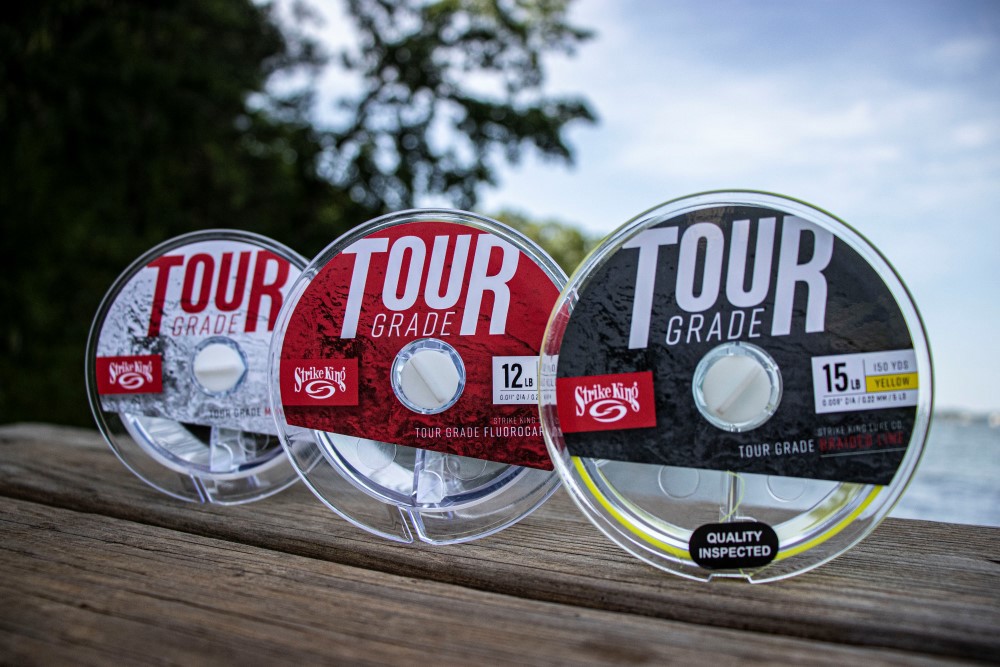By : Danger Kelly
In the late 80s, most fisherman used monofilament, which was undergoing various innovations to limit stretch, reduce the diameter to avoid light refraction, and limit the tendency of the line to saturate with water. All of this was derailed with the popularization of Fluorocarbon line, which is made from polyvinylidene fluoride and exhibits a number of superior traits when compared to monofilament.

Sensitivity – Because fluorocarbon is made from harder material than mono, the line transmits a greater level of vibration. This results in increased feel and is key in detecting subtle hits, especially in deeper waters.
Superior abrasion resistance – Fluorocarbon line is very rigid when compared to other lines, giving it the ability to encounter rock, wood, sand, and gravel without suffering a catastrophic failure.
Extremely low visibility – Because of the vastly increased strength when compared to mono, fluorocarbon can achieve a higher tensile strength than mono at a smaller diameter. Plus, fluorocarbon does not refract light as significantly as monofilament, making the line both smaller and less reflective. This effectively hides the line from fish observation.
Less stretching – The reduction in stretch in fluorocarbon lines makes it highly suitable to baits that require a stronger hookset. This is particularly valuable when fishing jigs in and around vegetation and cover.
Impermeability – Fluorocarbon does not saturate with water, which somewhat protects the integrity of the knot and maintains its abrasion resistance even after long periods of fishing.
UV resistance – The line does not suffer from exposure to sunlight and elements. It is also highly resistant to changing temperature.
When you consider these characteristics, you have a line that is superior to mono in nearly every way with the critical exceptions of neutral buoyancy and cost.
The drawbacks of fluorocarbon can be summed up in a single word: inflexible. This is essentially a hard line which is what makes it water and abrasion resistant. However, there can be several serious issues that derive from this that an angler must be aware of.
The first of these issues is knot failure. You may have seen many pros wetting a knot when they are tying fluorocarbon in order to ensure that the knot is tight and does not damage the line. This is realistically half the battle. Because of the rigidity of fluorocarbon, the angles imposed on a line by various knots weaken the line regardless of whether you wet it or not. Add to this the impact from usage and strain from catching fish, and fluorocarbon can break down at critical points such as during the hookset and while fighting a fish.
There is only one solution to this issue, and that is to be sure that you periodically retie your lure on a fresh portion of the line. In situations where I am catching multiple fish in short time windows, I will begin to retie every other fish, or if I catch any fish of significant weight or that puts up a serious fight. Many anglers have run into the demoralizing scenario where they feel a hit on their bait, and set the line into no resistance, coming back with just the line. This is a knot failure in nearly every case.
The second issue with fluorocarbon is the line breaking off in the reel. Being wound and unwound repeatedly can cause the line to break down and eventually snap off in the reel, waiting for a long cast that takes all the attached line with it.
The only solution to this issue is to restring fluorocarbon reels on a relatively short timeline. Yet because of the cost of fluorocarbon, this can be prohibitive. What I do to address this situation is to heavily back my reels with braid, and then string 75-100 yards of fluorocarbon on top of the braid.
The third issue to remember with fluorocarbon line is that as the stretch in a line decreases, the shock resistance of that line decreases as well. It is important to avoid confusing abrasion resistance with shock resistance.
Abrasion resistance is the ability of a line to survive damage from friction caused by rubbing on rocks and wood, etc.
Shock resistance is the ability of a line to survive a sudden strain caused by a hard strike, or a fish violently attempting to shake the hook.
This is where the line, the reel, and the rod combine to either increase or decrease the shock imparted by a hooked fish. On one side of the spectrum, you have a very stiff rod and a reel with minimal drag settings, coupled with a strong hookset and/or a very uncooperative fish. This setup will impart a maximal shock on the line. However, the opposite applies with a softer rod and setting the drag to give line under duress. This reduces the shock on the line while maintaining control over the fish.
My set up is as follows and I use this process on nearly every reel I plan to string with fluorocarbon.
This allows me to utilize the advantages of fluorocarbon while at the same time making it cost effective to put on new line at regular intervals. Plus, because the reel is at full capacity, it is easier to make long, accurate casts.